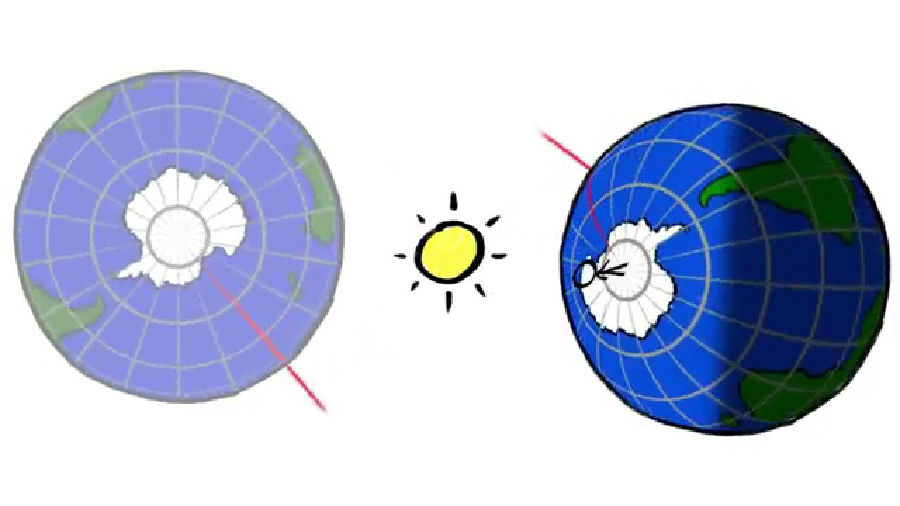In the Northern Hemisphere, December has the fewest hours of daylight and the most darkness
在北半球,12月拥有最短的昼和最长的夜
because at that time the tilt of the Earth's axis is pointing the Northern Hemisphere away from the Sun.
因为在那个时候,地球轴在北半球指向距离太阳最远的地方。
However, as counter-intuitive as it might sound, December actually has the longest days of the year.
但和直觉相反,其实12月拥有一年中最长的一天。
Modern clocks, of course, think every day is 86,400 seconds long, but that just the average length of a solar day over the course of the year.
当然,现代时钟将每天设定为86400秒,但这只是一年之中每个太阳日的平均长度。
A solar day is what you actually measure with a sundial, or equivalently it's the time it takes for a line of longitude on the Earth to rotate back to face the Sun again.
太阳日其实是用日晷测量的,或者相当于地球上一条经度线转回面对太阳所需要的时间。
This actually requires slightly more than 360 degrees of rotation because the Earth isn't just sitting in space rotating,
这实际上需要稍微多于360度的旋转,因为地球不仅是静止自转的,
it's also moving around the Sun so it has to rotate roughly 361 degrees
它还在绕着太阳旋转,所以它必须旋转大约361度,
before the Sun comes back perfectly overhead a particular place on consecutive days.
才能让太阳在接下来几天完全回到一个特定的位置。
If the Earth's orbit were perfectly circular and its axis were perfectly upright, that would be the end of the story.
如果地球的轨道是完整的圆,并且地轴完全是直立的,那么故事到此就结束了。
However, the Earth's orbit is elliptical, so sometimes the Earth is slightly closer to the Sun,
但是地球轨道是椭圆形的,所以有时候地球会离太阳更近一点,
and the peculiarities of gravity mean it moves faster when it's closer to the Sun,
而引力的特性意味着当它靠近太阳时,运动速度会更快,
so it goes farther around the Sun in 24 hours so the Earth has to rotate slightly farther before the Sun comes back right overhead.
所以地球在24小时内绕太阳转得更远,所以在太阳回到地球的正上方之前,地球必须转得更远一点。

0.033 degrees farther, to be precise. More rotation takes more time, so when the Earth is closest to the Sun,
准确地说,是多了0.033度。自转的时间更长,所以当地球离太阳最近时,
the real sundial measured day length is lengthened by about eight seconds. Plus the Earth's axis is tilted, which is what gives rise to the seasons,
日晷所测出的一天会多出8秒。再加上地球的地轴是倾斜的,所以就出现了四季更替,
but also means that at the time of year when the tilt points towards or away from the sun, narrower slices of longitude are aimed directly at the sun.
但这也意味着,在每年的这个时候,当倾斜指向或远离太阳时,更窄的经度是直接指向太阳的。
So as the Earth moves in its orbit, it has to rotate slightly farther in order for a particular line of longitude to catch up with the changing direction to the Sun.
因此,当地球在轨道上运行时,它必须稍微转得更远,以使一条特定的经度线赶上太阳变化的方向。
0.088 degrees farther, to be precise. And again more rotation takes more time, so when the Earth is tilted towards the Sun,
准确地说是0.088度。更多的自转需要更多的时间,所以当地球朝太阳倾斜时,
the real sundial measured day length is lengthened by about 21 seconds. Now by a strange coincidence,
日晷测量到的一天的长度会增加大约21秒。由于一个奇怪的巧合,
we live during a time in geologic history when the Earth's closest approach to the Sun
在我们现在所生活的地质年代,地球最接近太阳的时间
happens almost perfectly to coincide with one of the two times of year when the Earth's tilt is oriented directly towards the Sun.
正好与一年中的两次地球垂直朝向太阳的时间重合。
So these two day lengthening effects add up. And on December 22nd,
所以这两天的延长效应加起来。在12月22日这一天,
the length of a solar day as measured by a sundial will be the longest it is all year. 8643 seconds, for a grand total of 30 extra seconds.
日晷测量到的一个太阳日的长度将是一年中最长的一天。8643秒,总共多了30秒。
Oh, and in case you're wondering where those 30 extra seconds on December 22nd go,
如果你想知道12月22日这一天多余的30秒跑到哪里去了,
well they get pushed into December 23rd, and the extra seconds from the 23rd get pushed into the 24th, and so on
它们被推迟到了12月23日,而23日多出来的秒数又被推迟到了24日,以此类推,
which is why solar noon, or the time which the Sun is directly overhead, shifts about 30 seconds later every day around the solstice.
这就是为什么在冬至前后,太阳正午,或太阳高高挂在头顶的时刻每天都会推迟30秒。
This increasing disparity between solar time and clock time is also why, in the Northern Hemisphere,
太阳日和时钟时间之间不断增加的差异也能够解释,为什么在北半球
the earliest sunset happens a few weeks before the solstice, and the latest sunrise happens a few weeks after.
最早的日落发生在冬至前几周,最晚的一次日出发生在几周后。


